Violent conflicts, terrorism, global pandemics, and extreme weather events are exacerbating vulnerabilities, inequalities, and forced displacement, significantly heightening the risk of food insecurity among affected populations. These challenges emphasize the urgent need for comprehensive risk management, responsive emergency mechanisms, and resilience-building within the food system. The OECD projects that by 2030, 2.3 billion people will be living in fragile settings, including 80% of the world’s poor due to conflicts, disasters, displacement, and political discrimination. These crises represent the most significant and uncertain threats to food system stability and outcomes.
This section presents selected data on key trends in crisis and conflicts:
- Climate Crisis
- Forced Migration
- Global Pandemics
1. Climate Crisis
Projections
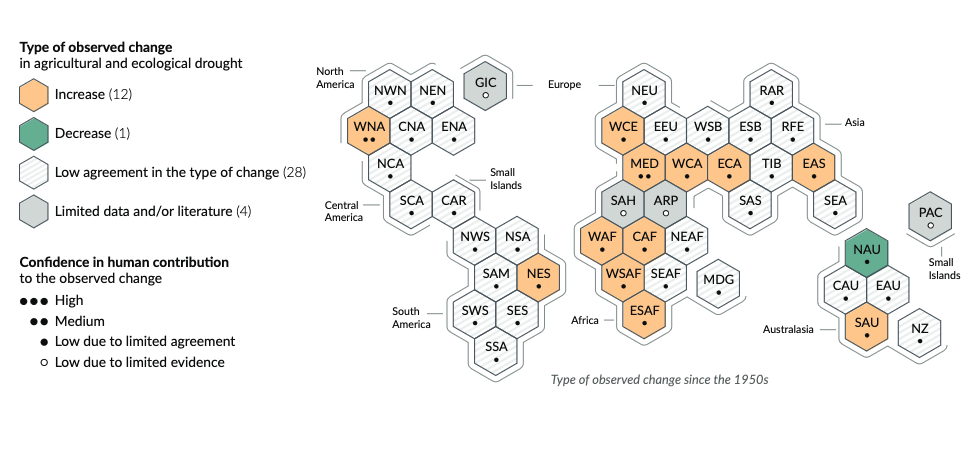
Several regions will be affected by more severe agricultural and ecological droughts even if global warming is stabilised at 2°C, including the Mediterranean (MED), West Southern Africa (WSAF), South American Monsoon (SAM) and Southern South America (SSA) (high confidence), and East Southern Africa (ESAF), Madagascar (MDG), (Eastern Australia (EAU), Southern Central America (SCA), (Caribbean (CAR) amongst others (shown in map)(medium confidence).
Some regions are also projected to be affected by more severe agricultural and ecological droughts at 1.5°C (like MED, WSAF, ESAF, SAM, SSA medium confidence) (IPCC, 2021). See regions in the figure.
Implications
Extreme climate events such as droughts, floods and storms, weather seasonal variations, and slow-onset processes such as sea level rise linked to climate change, are also unfolding interconnected emergencies. Extreme climate events impact food security and cause additional disruptions throughout value chains. Natural events such as floods, earthquakes and fires force millions of people to flee their homes each year. At the end of 2023, 7.7 million people were living in internal displacement due to disasters.
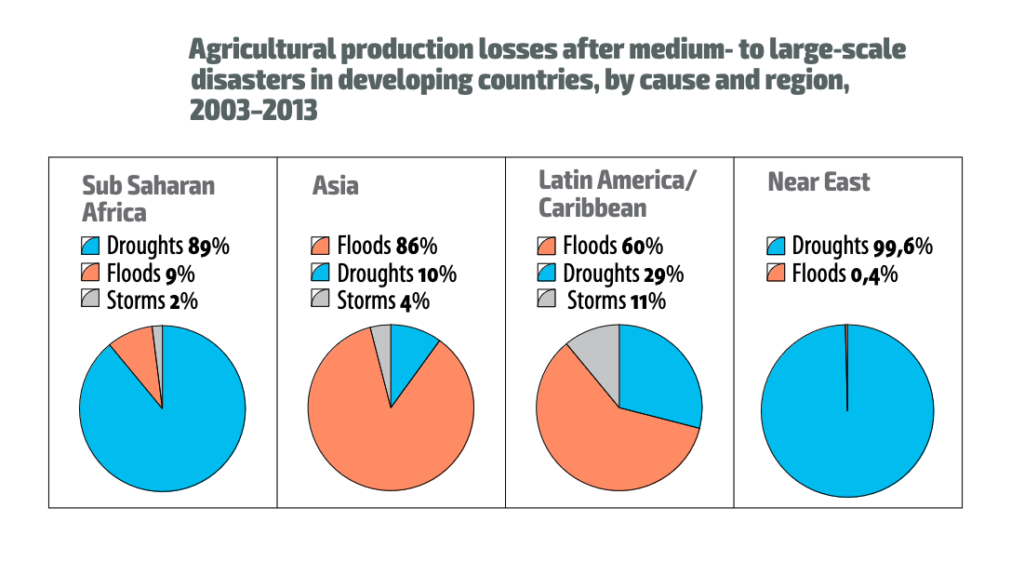
Not all disaster displacement is climate-related, but as climate change continues to make extreme weather events more common and more intense, even more people are at risk of being forced to flee their homes (Internal Displacement Monitoring Centre, 2025). Over half of all shocks to crop production systems have been the result of extreme weather events, reinforcing concern about the vulnerability of arable systems to climatic and weather volatility around the globe. Drought has been established as the single greatest culprit of agricultural production loss. Their impact on agrifood systems is difficult to forecast and measure (FAO, 2022).
2. Forced Migration
Trends
Most conflict-related and climate-related displacements took place in sub-Saharan Africa (SSA) and Near East and North Africa (NNA). The world is facing the largest forced displacement crisis ever recorded, with at least 100 million people forcibly displaced in the decade since 2010 (FAO, 2022). A continued increase in violent conflicts can be expected. This is true of Africa, where there were eight conflicts in 2005, compared to 25 in 2019. It is also true for Indigenous Peoples’ communities, against whom attacks have increased at an alarming rate in recent years. By 2050, climate change is expected to generate up to 86 million additional migrants in SSA, 40 million in South Asia (SAS) and 17 million in Latin America.
Implications
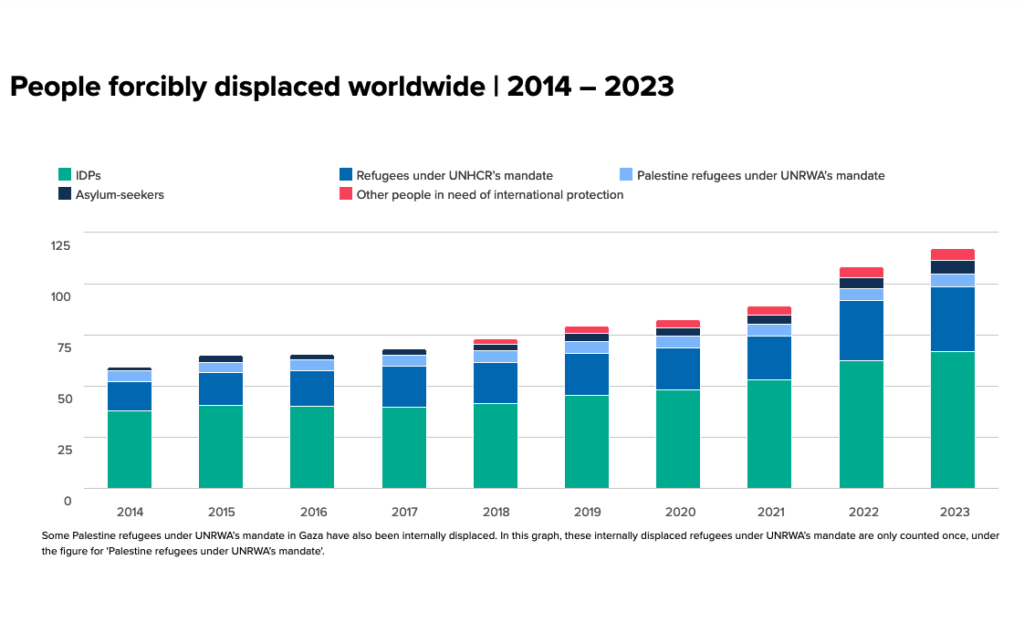
Forced migrations or displacement, often caused by political instability, violence, and climate change, lead to significant disruptions in agricultural production and food supply chains. These disruptions exacerbate food insecurity and malnutrition, particularly in low- and middle-income countries (LMICs) (Global Panel, 2020). Warming ocean temperatures are expected to drive smaller fish sizes, smaller fisheries, and significant migration of fisheries away from the tropics and toward the poles.
Territorial conflicts for protecting indigenous lands have also grown generating displacements. According to the UN, 40 to 60 per cent of armed conflicts over the past 60 years have been caused, funded, or sustained by the lack of natural resources. Displacement due to violent conflicts has reached an all-time high. The number of forcibly displaced people has doubled over the last ten years, outpacing countries’ ability to generate durable solutions.
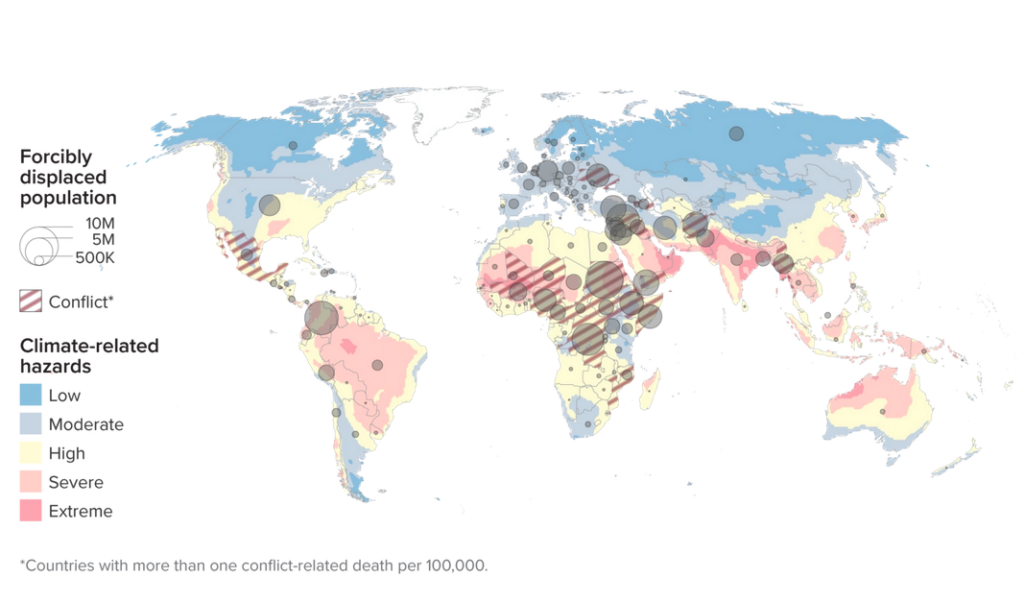
Global Pandemics
Global pandemics such as the COVID-19 pandemic have emerged as a significant driver and uncertainty of food systems, impacting multiple facets from production to consumption. There is no universal impact of the global pandemics, every region, value chain, family, and person are impacted differently. In the case of COVID-19, it impacted food systems by disrupting supply chains, altering demand patterns, and exacerbating food insecurity among the poorest. The UN assessed the risks of the COVID-19 pandemic on food security and livelihood in the food system in their policy brief. Lockdowns and travel restrictions led to labour shortages and logistical challenges, resulting in delays and wastage. Economic downturns reduced household incomes, limiting food accessibility and affordability, particularly among vulnerable populations.
In 2020, young workers (aged 15 to 24 years) incurred an employment loss of 8.7 per cent in 2020, almost 2.5 times greater than for adult workers. Official information released by Colombia, Costa Rica, Ecuador and Paraguay on the impact of the COVID-19 pandemic shows that monetary poverty increased sharply between 2019 and 2020 (FAO 2022). It has been estimated that there will be lingering impacts of the COVID-19 pandemic on food insecurity and nutrition by pushing more people into poverty. The pandemic induced millions of new poor in 2020 according to the World Bank report (Figure). Estimates suggest that the number of people who could be pushed into extreme poverty in 2030 may reach as high as about 179 million people, with around half of this increase occurring in the LIC. Were this to happen, the number of people who are acutely food or nutrition-incure will expand rapidly in as little as three months (UN, 2020).
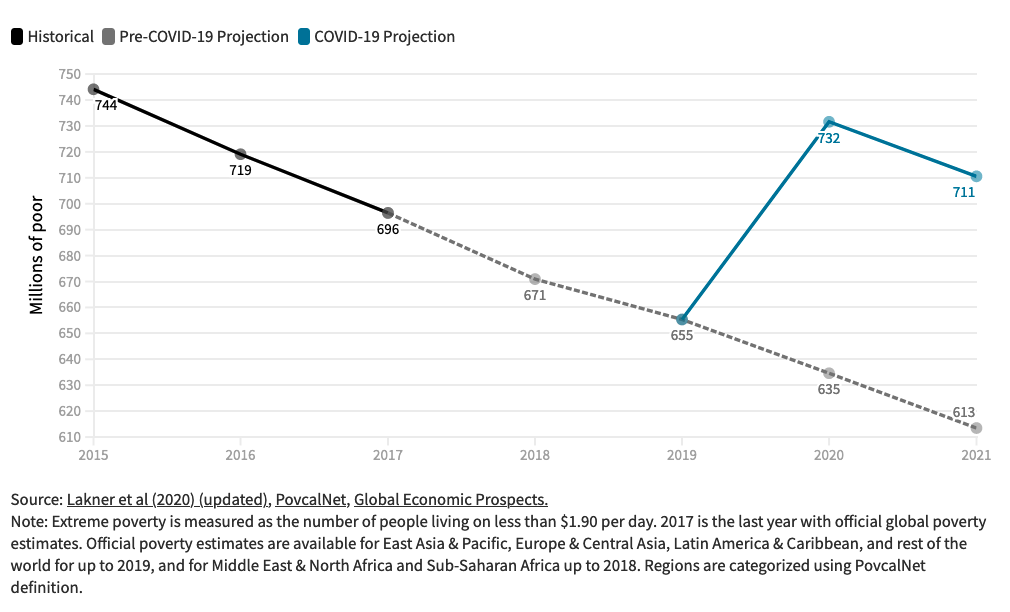
Consumer behaviour shifted towards non-perishable foods, causing supply-demand imbalances. The pandemic also accelerated the adoption of digital technologies in food distribution and agriculture, underscoring the need for more resilient and equitable food systems. In Kenya, digitisation was boosted during COVID lockdowns. For example, in 2020, 70 per cent of Kenyan farmers increased their use of mobile phones to send and receive mobile money and between March and May 2020, users of the youth-run agricultural marketplace, Mkulima Young, increased fourfold (GSMA, 2021).
Important Data Sources
The UN Refugee Agency collects data on the number of people forcibly displaced worldwide due to violent conflicts and climate-related challenges. Internal Displacement Monitoring Centre has been monitoring displacement associated with disasters since 2008. When compiling disaster displacement data, we track weather-related hazards such as storms, floods and wildfires as well as geophysical hazards such as earthquakes, volcanoes and tsunamis.
Please email info@foresight4food.net if we are missing any data updates.